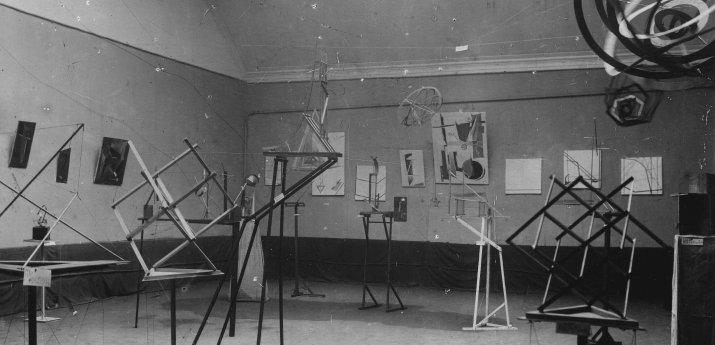
The exhibition Visionary Structures. From Iognason to Johansons is being organised by the Latvian Centre for Contemporary Art, and it offers an insight into Latvia’s avant-garde art in the 20th and 21st centuries – showcasing works by seven Latvian artists (Karl Iognason, Gustav Klutsis, Valdis Celms, Jānis Krievs, Artūrs Riņķis, Gints Gabrāns and Voldemārs Johansons), who represent different generations, each of whom is a trendsetting artistic innovator of his era. Through their works, these artists provide a view into the most experimental and utopian artistic values of their day, as well as into their historical transformations. By instigating a dialogue between different ages, the exhibition will reveal parallels and coherences between works of art, each of which belongs to a different age and another ideological era. The curator of the exhibition is Ieva Astahovska.
In the exhibition, the earliest generation will be represented by legendary artists from Latvia: Gustav Klutsis (1895–1938) and Karl Ioganson (1890–1929) who in the 1920s belonged to the Constructivist group in Moscow which is today considered to be one of the foremost examples of avant-garde art.
The selection of Gustav Klutsis’ works from the collection of the Latvian National Museum of Art will highlight the futuristic and utopian lines in his creative thinking. For the first time in Latvia, the exhibition will showcase Karl Ioganson’s spatial constructions – structures, in which the artist has revealed the principles of so-called tensegrity – universally applicable constructive systems which formulate potential manufacturing structures of a new type. To date, reconstructions of Karl Ioganson’s works have been displayed in exhibitions at the Russian Museum in Saint Petersburg and at the Solomon R. Guggenheim Museum in New York.
The chronological mid-section of the exhibition will be represented by three artists and designers: Valdis Celms (1943), Jānis Krievs (1942) and Artūrs Riņķis (1942). The works created by these artists in the 1970s and 1980s vividly testify to the fact that avant-garde and visionary works of art were also created in Latvia during the Soviet period, which are no less inspiring than similar line experimentations in the West in the 1960s and 1970s. The exhibition will showcase the kinetic objects created by these artists, as well as environmental installations, visionary proposals and so-called light painting, which are related both to the Cold War ideas of modernisation and the romanticised ideas of the Space Age.
The younger generation of artists participating in the exhibition is represented by Gints Gabrāns (1970) and Voldemārs Johansons (1981). Both artists’ newly created works are based on unique experiments in the synergy of art and science, involving visual interpretation of information and data intended to expand the boundaries of art and to peer into the micro-levels of reality.
The exhibition is being organised by the Centre for Contemporary Art in collaboration with the foundation Rīga 2014, the National Library of Latvia and the Latvian National Museum of Art. It is supported by the Ministry of Culture of the Republic of Latvia, the State Culture Capital Foundation, Riga City Council, ABLV Charitable Foundation, FineArtPrint, Arctic Paper, Rijada, Lordbaron, Eximus Studio, „Veselības centrs 4”, Juris Sils and Kārlis Dzelzītis. Media partners: the magazine IR, the magazine "Rīgas Laiks", the magazine "Studija", the magazine "Veto Magazine", Arterritory.com, RigaThisWeek.com, Easyget.lv, EchoGoneWrong.com, Clear Channel, EuroAWK.
The Latvian National Library is located at Mūkusalas Street 3, Riga.